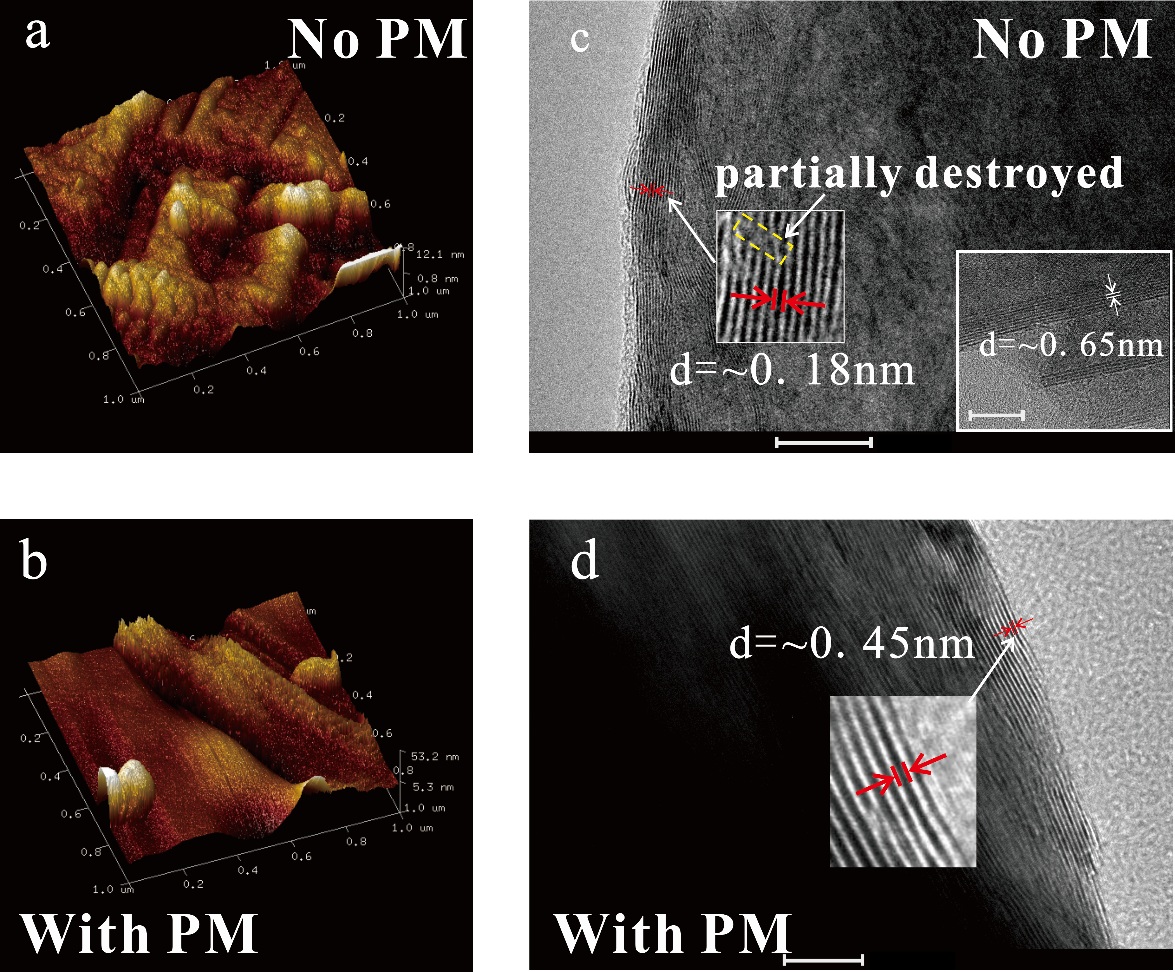 |
| Fig.(a) and (b) AFM images of pressure-induced morphology of MoS2 upon decompression from 23.9 GPa under non-hydrostatic conditions and 24.4 GPa under hydrostatic conditions, respectively. (c) and (d) TEM images of MoS2 upon decompression from 25.3 GPa under non-hydrostatic conditions and 24.8 GPa under hydrostatic conditions, respectively. Scale bars are 20 nm and 10 nm, respectively. Inset: TEM image of the initial sample. Scale bar, 10 nm.(Image by IGCAS) |
It is well known that most of the transition metal elements exist widely in a form of metallic oxide or metallic sulfide in the deep Earth crust. As a typical metallic sulfide, molybdenite (its correspondent chemical formula: MoS2) is of the representative layer mineral with a two-dimensional structure. Previous studies have shown that, in the monolayer of molybdenum disulfide, one metal atom (Mo) plane is sandwiched by two chalcogen atom (S) planes, forming a trigonal prismatic coordination. The MoS2 layer is interconnected by the d-orbital state of the Mo atom with the van der Waals force. Different layer stacking patterns form a variety of crystal structures, like the 2Ha and 2Hc structure. It has been demonstrated that chemical doping, intercalation and surface functionalization can change the structure of MoS2. Molybdenum disulfide has been widely applied in the field of mineralogy and material science.
Recently, Prof. DAI Lidong’s group successfully established a completely new experimental platform on the measurement of electrical property by electrochemical impedance spectroscopy at high temperature and high pressure in the Key Laboratory of High-Temperature and High-Pressure Study of the Earth’s Interior of Chinese Academy of Sciences at Institute of Geochemistry, Chinese Academy of Sciences (IGCAS).
Dr ZHUANG Yukai from DAI Lidong's group systematically investigated the high-pressure behavior for molybdenum disulfide by virtue of the impedance spectroscopy, Raman spectroscopy, atomic force microscopy image and transmission electron microscopy image under conditions of 1 atm?25 GPa and 93 K (ultralow temperature)?293 K (atmospheric temperature).
The study has found that there is a structural phase transition and metallization characterization in molybdenum disulfide at 17 GPa with a non-hydrostatic condition, and the structural phase transition is of the reversibility, and however the metallization is irreversible. As for the hydrostatic condition, the structural phase transition and metallization occurs at 20 GPa, and both of structural phase transition and metallization are reversible. The discrepancy of pressure-induced phase transition and metallization is due to the feature of the layered structure of molybdenum disulfide.
The results disclose that the pressure medium had a significant influence on the high-pressure electrical properties for most of other layered minerals (especially for Molybdenum Disulfide). It is observed for the first time that the permanent metallization in molybdenum disulfide exists under the condition of no pressure medium.
The metallization of molybdenum disulfide has been reasonably interpreted by means of in-situ measurements including the impedance spectroscopy, Raman spectroscopy, atomic force microscopy images and transmission electron microscopy images in detail. This study shows the evidences that the metallization is caused by the overlap of band gap rather than structural phase transition.
The researchers predict that many other layered materials may also contain similar properties and it may have potential applications in semiconductor electronic devices.
This work has been published in the top journal of Nature Index as follows,
Zhuang Yukai, Dai Lidong*, Wu Lei, Li Heping, Hu Haiying, Liu Kaixiang, Yang Linfei and Pu Chang. Pressure-induced permanent metallization with reversible structural transition in molybdenum disulfide.Applied Physics Letters, 2017, 110, 122103, doi: 10.1063/1.4979143.
Contact:
DAI Lidong
Institute of Geochemistry, Chinese Academy of Sciences
E-mail: dailidong@vip.gyig.ac.cn
(By Prof. DAI Lidong’s group)